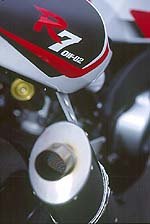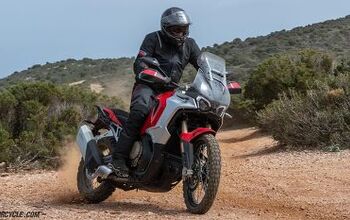1999 Yamaha YZF-R7 OW-O2 - Motorcycle.com
It is built for the track and it shows. The faster you ride it the more it likes it. Motorcycle Online correspondent Glenn Le Santo became one of the few people in the world who will ever experience the thrill of the Yamaha YZF-R7. Should you be envious? Read on and find out for yourself.
Great Britain, April 5, 1999 -- The Yamaha YZF-R7 OW-O2 has one purpose in life: To win races. You may have seen it displayed in various shows with lights and road gear but these have only been added in order to homologate the bike to meet F.I.M. regulations. Only 500 exacting, hand-made machines are being produced, making it one of the rarest production bikes ever to leave a Japanese factory. Even if you could afford the £20,000 ($32,000 USD) sticker price, you couldn't actually purchase the bike unless you can prove you have a full season's racing ahead of you. Of course, you
could always sponsor a rider. Then at the end of the season you have an awesome track day tool to play with, if there is anything left of it after a hard year of racing at the Superbike level.
Technical SpecificationsAt first glance its spec sheet reads just like that of the YZF-R1 or R6. Like its cousins, the R7 is powered by a slant block, in-line, liquid-cooled, four-cylinder, four-stroke engine used as a fully stressed member of the chassis. But closer inspection of the spec sheet shows a wide divide between this racer and its road-going relatives.Breathing and combustion
First, the bike is fuel injected. The electronic twin-injector system meters fuel into the intakes which receive air from a massive 15-liter airbox, but without any ram-air ducting. All that air and unburned fuel is squeezed into the combustion chambers via 12 titanium inlet valves mounted in a CNC-machined cylinder head. This mixture is then squashed to 11.4 times atmospheric pressure by ultra-strong, ultra-light, short-skirt forged pistons with plated crowns. The pistons connect to the ion-nitrified crankshaft by "H" section titanium con-rods. Burned mixture is expelled past eight more titanium valves held in place by aluminum valve retainers. Plated cylinders and a one-piece crank are not unique technology but it's better to have them than not.
In order to ensure that the bike complies with a host of emission laws, Yamaha has shut down one of the two injectors per cylinder. This is how the bike is capped at 105 horsepower. Turn on the other injector, add a high-level, free-flowing exhaust system, make a minor modification to the ECU wiring, fit a high pressure fuel pump and the R7 will produce a claimed 135 horsepower. In full race trim expect this figure to rise to around 150 horsepower.
Along with the other YZF-R series Yamahas, the R7 features compact and lightweight direct-ignition coils mounted in the spark-plug caps and is fed sparks from a compact, high-output AC generator via a DC-CDI arrangement. The multi-function ECU monitors crankshaft and camshaft speed, throttle position, temperature and pressure as well as controlling ignition timing and volume. The ECU also features a self-diagnostic system to help assist race mechanics.
Brakes, Wheels and Suspension.
The homologated YZF-R7 comes with two four-pot, one-piece calipers biting into dual 320mm discs, similar to the R1. Expect any self-respecting racer to throw them away in favor of a more race-ready set-up. Likewise with the heavy (for racing) R1 derived wheels, which will quickly be junked in favor of something much lighter. Front and rear Ohlins suspension is fully adjustable and the front sliders are coated with titanium nitrite to reduce friction.
Transmission
You may be surprised to learn that the YZF-R7 is not fitted with a dry clutch, although the wet multi-plate clutch does feature a back torque limiter to prevent lock up during aggressive down-shifts. The gearbox is a six-speed close-ratio racing set-up. The gear shafts are mounted in the now familiar tri-axis arrangement and "stacked" vertically instead of horizontally to shorten the engine, allowing Yamaha to fit a longer GP style swingarm yet still keep its ultra-short 1,400 mm (55 inch) wheelbase. Take a look at Yamaha's YZR GP race bike and notice how similar the YZF-R7's black aluminum frame looks. It should since Yamaha based the R7's chassis as closely as possible to their two-stroke GP bike.
Riding the YZF-R7
Handling
The brakes are powerful, as you might expect since they are very similar to the R1's set-up. What surprised me was their feel. They are very progressive, a nice touch because they are so powerful. The rear brake was also a gem. Too many motorcycles have rear brakes that are all or nothing. Not the R7, its rear brake is powerful and progressive.
The bike is not designed for road use and is set-up rather stiffly. On the bumpier roads the rear shock transfers every jolt to the kidneys. The suspension is a lesson in control, despite the stiff set-up, and while on the bumpy Yorkshire roads the wheels stayed glued to the ground. Only when gunning the R7 hard down a particularly bumpy straight was there even a hint of flap from the front-end. With the front wheel lightened from acceleration the bars would give a slight twitch in the riders hands, but it was far from the violent slapping the road might have induced on lesser bikes. And this was without a steering damper.
Engine
The engine surprised us. Here we had a brand new bike, only two hours out of the crate and restricted to comply with the toughest regulations in Europe yet it was far from feeling tight, strangled or capped -- the power delivery was sensational. Here is a 100 horsepower, 750cc inline four that thinks it's an RC45. Apart from a little emission-controlled fluffiness below 3,000 rpm the power delivery was impeccable.
Blip the throttle at tick over and the revs rise and fall at a moments notice, indicating the lightness of the crank and piston assembly. Get the R7 rolling and twist open the race action throttle a quarter turn -- to full open -- and the bike lunges forwards without hesitation. Between 4,000 and 6,000 rpm it pulls very respectably, comparable to my own Thunderace (Yamaha YZF-1000). Once the revs cross the 6,000 mark the bike pulls stronger than any "restricted" 750 has a right to. Despite being brand spanking new the bike was hungry for revs and the tach needle really moved by the time it swept past 10,000. Sympathy should have forced a gear change at this point, but the top-end rush was so addictive I couldn't resist letting it run on to 12,000 rpm. For a bike with little more than a few miles in its bores it felt very free revving. I couldn't wait to ride it in kitted form, and judging by the look on his face neither could Dean Ashton.


































Comments
Join the conversation